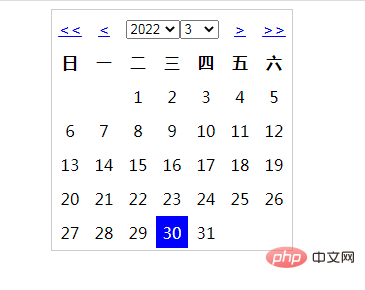PHP를 사용하여 간단한 달력 프로그램을 구현하는 방법은 무엇입니까? 이 기사는 PHP를 사용하여 간단한 달력 프로그램을 구현하는 방법을 이해하는 데 도움이 되는 코드 예제를 사용합니다.

날짜와 시간을 처리한다고 하면 달력 프로그램 작성을 소개해야 합니다. 대부분의 독자들은 달력의 기능이 현재 날짜만 표시하는 것이라고 생각할 수도 있습니다. 날짜 페이지에서는 실제로 달력이 우리 개발에 더 중요한 역할을 합니다. 예를 들어, "메모장"을 개발할 때 달력을 통해 날짜를 설정해야 합니다. 또한 일부 시스템에서는 날짜별로 작업을 정렬하기 위해 달력을 사용해야 합니다.
이 섹션의 예제에 포함된 날짜 및 시간 함수는 모두 이전에 소개되었습니다. 주요 목적은 달력 클래스를 작성하여 앞서 소개한 객체 지향 및 시간 함수 애플리케이션을 통합하는 것입니다. 동시에 예제에는 몇 가지 프론트엔드 지식이 포함되어 있습니다. 관심 있는 독자는 이 사이트에서 제공하는 HTML 튜토리얼 및 CSS 튜토리얼을 읽어보세요.
전체 샘플 코드는 다음과 같습니다.
<?php
class Calendar{
private $year, $month, $start_week, $days;
/**
* 构造方法,用来初始化一些日期属性
*/
function __construct(){
$this->year = isset($_GET['year'])?$_GET['year']:date('Y');
$this->month = isset($_GET['month'])?$_GET['month']:date('m');
$this->start_week = date('w', mktime(0, 0, 0, $this->month, 1, $this->year));
$this->days = date('t', mktime(0, 0, 0, $this->month, 1, $this->year));
}
/**
* 魔术方法,用来打印整个日历
* @return string [日历的html代码]
*/
function __toString(){
$output = '';
$output = '<table>';
$output .= $this->changeDate();
$output .= $this->weeksList();
$output .= $this->daysList();
$output .= '</table>';
return $output;
}
/**
* 输出周列表
* @return [string] [html 代码]
*/
private function weeksList($output=''){
$week = array('日','一','二','三','四','五','六');
$output .= '<tr>';
for ($i=0; $i < count($week); $i++) {
$output .= '<th>'.$week[$i].'</th>';
}
$output .= '</tr>';
return $output;
}
/**
* 输出日期列表
* @return [string]
*/
private function daysList($output=''){
$output .= '<tr>';
for ($i=0; $i < $this->start_week; $i++) {
$output .= '<td> </td>';
}
for ($j=1; $j <= $this->days; $j++) {
$i++;
if($j == date('d') && $this->year == date('Y') && $this->month == date('m')){
$output .= '<td>'.$j.'</td>';
}else{
$output .= '<td>'.$j.'</td>';
}
if($i%7 == 0) $output .= '</tr><tr>';
}
while($i%7 !== 0){
$output .= '<td> </td>';
$i++;
}
$output .= '</tr>';
return $output;
}
/**
* 处理上一年的数据
* @param [type] $year [年份]
* @param [type] $month [月份]
* @return [type] [description]
*/
private function prevYear($year, $month){
$year -= 1;
if($year < 1970) $year = 1970;
return "year=$year&month=$month";
}
/**
* 处理上一月的数据
* @param [type] $year [年份]
* @param [type] $month [月份]
* @return [type] [description]
*/
private function prevMonth($year, $month){
if($month == 1){
$year -= 1;
if($year < 1970) $year = 1970;
$month = 12;
}else{
$month--;
}
return "year=$year&month=$month";
}
/**
* 处理下一年的数据
* @param [type] $year [年份]
* @param [type] $month [月份]
* @return [type] [description]
*/
private function nextYear($year, $month){
$year += 1;
if($year > 2038) $year = 2038;
return "year=$year&month=$month";
}
/**
* 处理下一月的数据
* @param [type] $year [年份]
* @param [type] $month [月份]
* @return [type] [description]
*/
private function nextMonth($year, $month){
if($month == 12){
$year --;
if($year > 2038) $year = 2038;
$month = 1;
}else{
$month++;
}
return "year=$year&month=$month";
}
/**
* 调整年份和月份
* @param string $output [html代码]
* @param string $url
* @return [type]
*/
private function changeDate($output='', $url='index.php'){
$output .= '<tr>';
$output .= '<td><a href="'.$url.'?'.$this->prevYear($this->year, $this->month).'">'.'<<'.'</a></td>';
$output .= '<td><a href="'.$url.'?'.$this->prevMonth($this->year, $this->month).'">'.'<'.'</a></td>';
$output .= '<td colspan="3">';
$output .= '<form>';
$output .= '<select name="year" onchange="window.location=\''.$url.'?year=\'+this.options[selectedIndex].value+\'&month='.$this->month.'\'">';
for ($i=1970; $i <=2038; $i++) {
$selected = ($i == $this->year)?'selected="selected"':'';
$output .= '<option value="'.$i.'" '.$selected.'>'.$i.'</option>';
}
$output .= '</select>';
$output .= '<select name="month" onchange="window.location=\''.$url.'?year='.$this->year.'&month=\'+this.options[selectedIndex].value">';
for ($j=1; $j <=12; $j++) {
$selected = ($j == $this->month)?'selected="selected"':'';
$output .= '<option value="'.$j.'" '.$selected.'>'.$j.'</option>';
}
$output .= '</select>';
$output .= '</form>';
$output .= '</td>';
$output .= '<td><a href="'.$url.'?'.$this->nextMonth($this->year, $this->month).'">'.'>'.'</a></td>';
$output .= '<td><a href="'.$url.'?'.$this->nextYear($this->year, $this->month).'">'.'>>'.'</a></td>';
$output .= '</tr>';
return $output;
}
}
?>
<!DOCTYPE html>
<html>
<head>
<meta charset="UTF-8">
<title>PHP实现简单的日历程序</title>
<style>
table{
border: 1px solid #ccc;
}
.fontb{
color: white;
background: blue;
}
th{
width: 30px;
}
td,th{
height:30px;
text-align: center;
}
form{
margin: 0px;
padding: 0px;
}
</style>
</head>
<body>
<?php
$calendar = new Calendar;
echo $calendar;
?>
</body>
</html>실행 결과는 아래와 같습니다.

추천 학습: " PHP 동영상 튜토리얼》